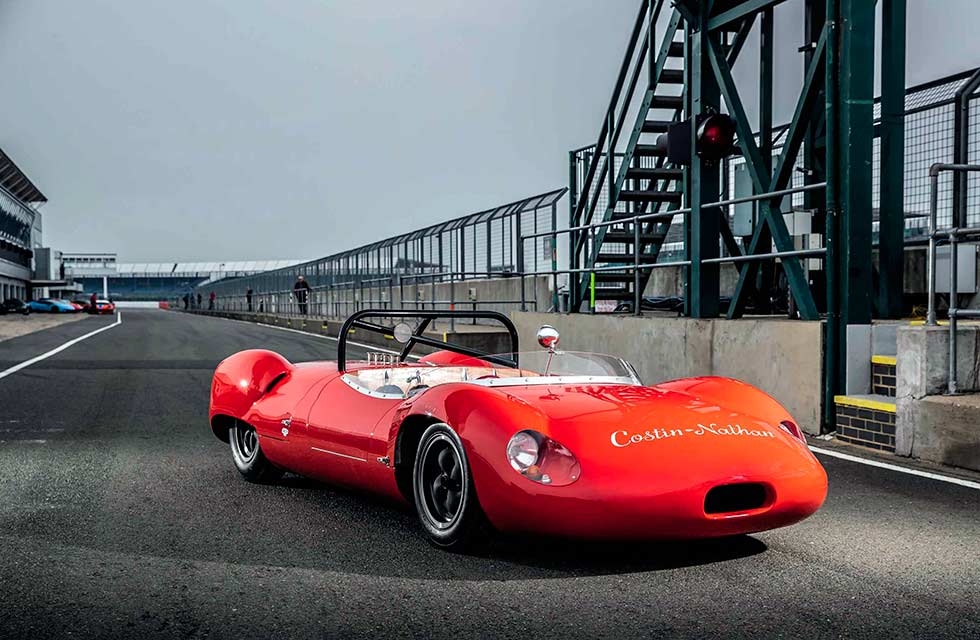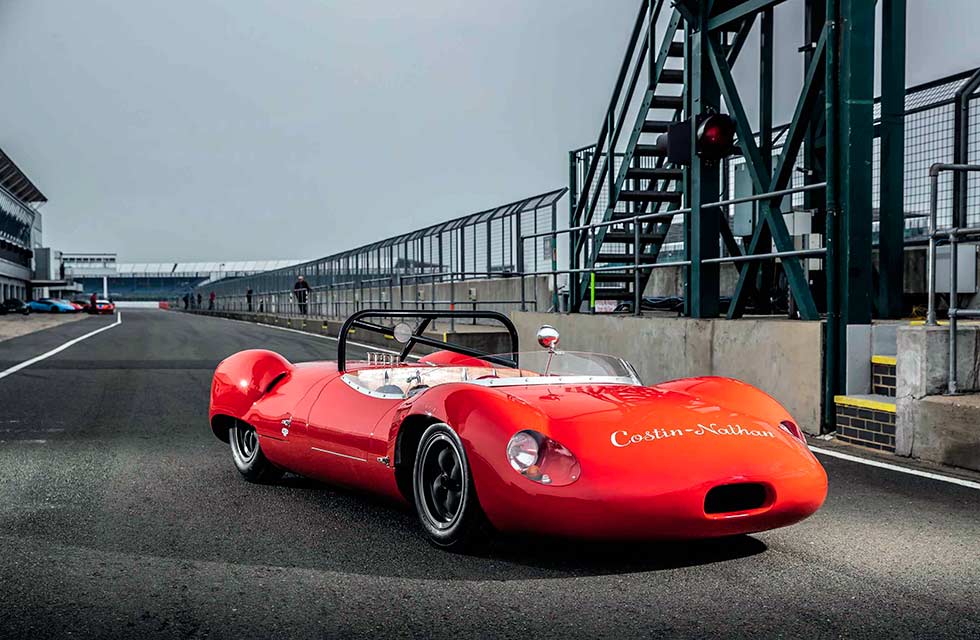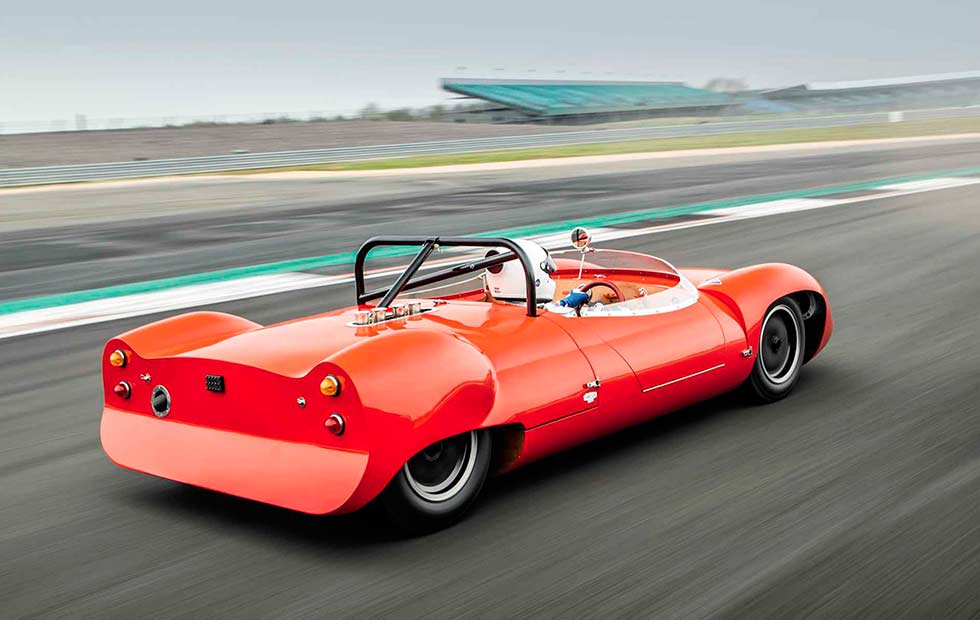
Advanced aerodynamics and a tuned Imp engine made a giant-killer of the tiny, wood-framed Costin-Nathan. Drive-My gets to know the recently rebuilt prototype. Words James Page. Photography Charlie Magee.
COSTIN-NATHAN The racing car he built first – now restored
Return of the giant killer
Even in a pitlane containing everything from Citroen C1s to Lola T70s, the Costin-Nathan stands out. Not often do you see a racing car made largely of wood, and throughout the day people do a double-take as they register its untrimmed cockpit. Few seem to know what it is, despite the ‘Costin- Nathan’ script across the nose, one notable exception being Willie Green, who enthuses about racing against it during the 1960s.

Running his hand over the newly painted bodywork is Roger Nathan himself – the man who, more than 50 years earlier, teamed up with Frank Costin to make this car a reality. He’s recently overseen its restoration and is about to reacquaint himself with both the car and with Silverstone itself.
‘Copse is the only corner I recognise,’ he says with a smile after a few shakedown laps, the eight-corner layout of decades ago having been replaced by the 18 turns of the current Silverstone Grand Prix circuit. Despite that, he professes himself happy with the handling and enthusiastically offers us a few laps.

The car is small and incredibly low, and the driving position reclined, so once ensconced you feel as if you look up at everything; alongside us in the garage is a pre-war Aston Martin, which towers above. The rev-counter is in the middle of the dashboard, and to the right are the read-outs for oil pressure and water temperature. The gauges below that are largely obscured by the right-hand gearlever, but directly in front is a large oil-pressure warning light, which brings to mind the Brockbank cartoon showing a racing car with an oversized revcounter and the driver saying to his mechanics: ‘I’ve had enough of your thinly veiled insults.’
The 998cc Hillman Imp engine does little below 4000rpm, but from there it runs crisply up to more than 7000rpm. It’s giving 108bhp, enough to offer impressive acceleration in a car that weighs only 410kg. The gearing is short for the wide open spaces of Silverstone’s GP layout and 7000rpm in top comes up on almost every straight stretch of tarmac. At the end of Hangar Straight, a small light indicating 7500rpm blinks on.
But the main thing that stands out is the immense grip. Sir Jackie Stewart once said of the Lotus 33 that its centre of gravity seemed to be 12 inches below the track surface, such was the traction on offer. Through the long right-handers at Stowe and Brooklands, the Costin-Nathan evokes the same feeling as it just sits there, completely unruffled as your left hip gets pressed with increasing force against the unforgiving wooden tub.
A Porsche 911 comes past on the approach to Copse, but all the way through the Becketts complex the diminutive sports-racer is closing the gap again. Its cornering abilities are such that a proper driver would hardly have to back off between Brooklands and Club corners, perhaps half the lap, and the whole package is a lesson in what can be achieved with a lightweight, aerodynamic design. Less, in this case, is definitely more. This car was the prototype for what turned out to be a short production run of no more than 20 Costin-Nathans, which ended up being produced in both open and closed forms. Roger Nathan had made a name for himself racing a Lotus Elite and a Brabham BT8 during the early 1960s, as well as running a tuning company with ex-Lotus mechanic Willie Griffiths. When the Hillman Imp was launched in 1963, they became well known for their work on its four-cylinder aluminium engine.
During his time at Lotus, Griffiths had got to know Frank Costin, the former head of aerodynamic flight testing at de Havilland who’d gone on to work on the Vanwall Grand Prix car as well as Colin Chapman’s MkVIII, MklX and Eleven.
‘Frank would pop in to talk to Willie,’ recalls Nathan. ‘He mentioned that he had a design for a new sports car, and he was looking for a small, powerful engine to go in it. Willie said to him: “Go and pick up that engine on the bench.” Frank told him not to be daft, but Willie said it again so Frank went over, put his arms around this Imp engine and picked it up!
‘He said: “This is amazing. How much power does it give?” In those days, it was giving about 85bhp. He said that it was just what he wanted, and from that he told us about the car.’
Nathan struck a deal that would involve Costin supplying the monocoques, while he and Griffiths – who had recently been joined by another ex-Lotus mechanic, Cedric Selzer – would build the cars, develop them, and market them for sale. The plan was to finish the prototype in time for the Racing Car Show in January 1966.
‘We were rushing like mad because we’d arranged to have a preview night at the Dorchester hotel. We had a room booked and sent out press invitations. Frank turned up the day before the launch with an unpainted car! We got it painted in the early hours, put it on the trailer and got it to the Dorchester with the paint still drying.’
The monocoque was made from resin-bonded Gaboon plywood and tubular subframes were bolted to it front and rear. Suspension was by wishbones all round, with coil-over dampers. A race-spec Imp engine was fitted but flipped through 90° in comparison to how it was mounted in the standard road car, so that the exhaust manifold faced upwards. It transmitted power through a four-speed Imp gearbox that had been modified by Jack Knight.
Nathan raced the prototype throughout 1966, picking up class wins and lap records on a regular basis, but his biggest success came at the Coupes de Paris meeting at Montlhery that September. The entry had been arranged via his Continental agent, Dr Mollof.
‘We went to scrutineering and opened up the panels, and people saw it was wooden and started laughing! In particular the Abarth team manager, Signor Avidano. Here was I, an Englishman, 22 years old with his own wooden car, up against the might of Fiat!’
The laughing stopped when Nathan claimed pole position, but he knew that he had to lead into the first corner, otherwise the more powerful Abarths would be able to pull away: ‘I made a good start and in the lower gears because the car was so light, I was quicker, we got up to 100mph approaching the first bend, I could see this car coming up in my peripheral vision. He actually got his front wheel just beyond me and we both left the braking too late and all of a sudden he’d gone – he’d put the brakes on.
‘I went into this corner too fast and the thing immediately slewed sideways. I had a quick look in the mirror and saw that they’d all backed off – they thought that I was going to have a monumental accident and they didn’t want to get involved! At the very last centimetre of track it held, and I pulled away.
‘I won by a huge margin – something like half a minute in the end. The car never missed a beat. I came in and French TV was there, and two lovely girls gave us Champagne. I thought, this Continental racing is good stuff!’
Nathan collected his £500 prize money, only to learn that Abarth had protested the car, claiming that its Perspex windscreen was illegal. The matter rumbled on into the winter: ‘They eventually decided that I could keep the prize money – which I’d spent anyway – and retain the cup and my win stood, but they’d award Abarth the points in the championship. I couldn’t care less about that because I wasn’t in the championship.’
The prototype was sold at the end of the season, and was bought by GM Horsley for Chris Meek to drive. Horsley paid £1300 for the car minus its engine and gearbox because he wanted to fit a Lotus Twin Cam unit. During 1967, it was crudely converted into a GT – ‘I gave him a bargain price of £300 for the two doors, the roof, the glass screen and the screen surround,’ Nathan recalls – but it wasn’t raced very often and was eventually laid up.
For 45 years it languished in a garage until it was found by a house clearance company following Horsley’s death. It was offered for sale by H&H in July 2016, and despite being in need of a complete restoration it went for £80,230.
‘Somebody from H&H got in touch,’ says Nathan, ‘and said: “Would you like to be there for the auction?” I actually went there thinking that I might be able to buy the car myself for about £10,000 – if I wanted it, and I wasn’t sure I did! When I saw it, the Ford engine was scrap, so was the Hewland ’box. It was in a terrible state – mouldy, rotten and rusty. But the price kept going up and up!’
About three weeks later, Nathan got a call from the car’s new American owner, who asked him to become involved with its rebuild. He flew to the States and they came up with a plan to return it to its original 1966 form, complete with Imp engine and open bodywork. Kent-based Rawlson Racing had come highly recommended, so Nathan – who would act as project manager – went down to see Guy Sheppard and John Sabourin, and came away suitably impressed.
‘First, I had to find out who could do the monocoque. I had a contact in Australia called Bruce Mansell. He’d bought one of my cars. I was on the phone to him one day and said that I was looking for someone to do the monocoque. He said: “I know someone – Mr Wood.” I said: “Come on – what’s his name?” He said: “Mr Wood”. I asked what his first name was and he said: “Friend”.
‘Well, I didn’t believe that for a start, but it was true! I contacted Mr Wood in deepest South Wales. He was on a sheep farm – lived there with his 86-year-old mother – but he did this wonderful woodwork. Also, he had built wooden cars before.’
The work was complicated by the fact that Costin had never produced any drawings and they didn’t have the jigs or tooling that Nathan created in period. All we had were pictures of the cars and the original brochure. Luckily I found the right people in John and Guy. As far as we can get it, it’s exactly the same as it was in 1966. The monocoque is exactly the same. Friend Wood had to copy what was left of the old one, and use common sense and his knowledge of what Frank’s work was like. He did a wonderful job.’
The prototype was the only Costin-Nathan to feature aluminium bodywork, subsequent cars using glassfibre instead. That side of things was entrusted to Classic Autos, which did a stellar job in saving what was left and replacing the badly corroded sections. The engine, meanwhile, was built by Ben Boult, an ex-Rootes man.
‘It’s been a lot of work, running around and finding all the bits. We tried to use as much of the original as we could. The front wishbones are original and much of the front frame, but the rear suspension and subframe had rusted through. The calipers were salvageable, but we couldn’t use the uprights and the magnesium wheels are new.’
Work started on the car in September 2016, so it was two-and-a-half years before it was again able to turn a wheel in anger. Nathan now hopes to run it at selected meetings, not to recreate the glories of Montlhery but to have some fun and show off a fascinating piece of racing history. And when it’s not doing that, it’ll be on display at the National Motor Museum, where no doubt it’ll attract the same amount of curiosity as it does in the Silverstone pitlane.
‘It’s been fantastic,’ says Nathan, Tike a new lease of life. It’s nice to get problems solved with good people like John and Guy, who really appreciate it. They’ve taken pride in the whole job – it’s like having a team again, all working together because you want to do it.’
Above and right – Roger Nathan reunited with the car he helped create, and enthusing to our man Paqe after laps of Silverstone. Costin-Nathan is incredibly low – and light, at a mere 410kg. Left and above Slippery shape was the work of aero wizard Frank Costin; all-aluminium 998cc Imp engine is tuned to 108bhp; plywood monocoque caused amusement back in the day. Left and below – At speed on the Silverstone GP circuit following fastidious restoration (below), which involved conversion from later GT coupe form to original open prototype bodywork. Above – Shakedown test completed, the car will now have a few minor niggles sorted before it’s entered in a limited programme of race meetings, rolling back the years in unique style.
THANKS TO the British Racing Drivers’ Club for the use of Silverstone.
1966 Costin-Nathan
Engine 998cc OHC four-cylinder, aluminium alloy, two Weber 38 D6NL carburettors
Max Power 108bhp @ 7600rpm
Max Torque 79.5lb ft @ 4700rpm
Transmission Four-speed manual, rear-wheel drive
Steering Rack and pinion
Suspension
Front: double wishbones, coil springs, telescopic dampers.
Rear: lower wishbones, top links and radius arms, coil springs, telescopic dampers.
Brakes 9.5in discs
Weight 410kg (with fluids)






